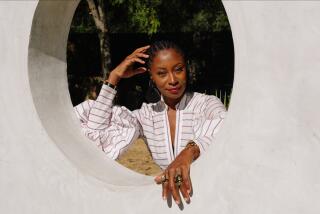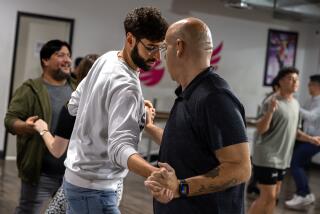Dance pioneer David Gordon revisits ‘Trying Times’
David Gordon, writer, director and choreographer, acknowledges a practical reason for reworking his 1982 stage piece “Trying Times,” this time as “Trying Times (remembered).” The National Endowment for the Arts offered him a grant to do it -- and times are tough when it comes to funding in the arts.
“It’s the only piece anybody ever gave me money to revisit,” Gordon says.
FOR THE RECORD:
David Gordon: An article in Tuesday’s Calendar about writer-director-choreographer David Gordon misspelled the first name of one of his “Trying Times” collaborators, Power Boothe, as Powers. —
FOR THE RECORD:
David Gordon: An article in Tuesday’s Calendar section on choreographer David Gordon referred to the Sharon Disney Lund School of Dance as REDCAT’s Sharon Disney Lund School of Dance. The dance school is one of the schools at CalArts, not REDCAT. —
Even though the self-deprecating dance-maker was monumentally uncomfortable with the idea of submitting his work to the NEA in a grant category with the title “American Masterpieces,” he allowed his manager-producer to send in an application -- and, even though Gordon was none too sure, the NEA indeed found “Trying Times” worthy of the “masterpiece” title.
“So, here we are,” Gordon says, still sounding just a little surprised.
Here, in this case, is a rehearsal space at CalArts, where Gordon and his Pick Up Performance Co(S.) were rehearsing last week for “Trying Times” (remembered),” to be performed Wednesday through Sunday at REDCAT before moving on to a two-week run at the Dance Theater Workshop in New York, which commissioned the original.
Because the new version is a co-production of Gordon’s company and REDCAT’s Sharon Disney Lund School of Dance, eight CalArts dancers who were not yet born in 1982 are joining Gordon’s own dancers in the cast, and CalArts is lending rehearsal space on its Valencia campus -- so, here we are.
Despite citing the financial motivation for revisiting one of his dances -- something he has never done before -- Gordon, often described as a postmodern choreographer, is relishing the challenge of rethinking “Trying Times,” set to the score of Stravinsky’s “Apollo” and inspired by George Balanchine’s signature ballet.
He says he was introduced to Balanchine’s work by New Yorker dance critic Arlene Croce, who frequently took him to performances. “She had wonderful tickets to New York City Ballet that I could not afford,” he jokes.
The title “Trying Times” stemmed from the fact that Gordon, now 72, entered the dance world through the back door -- first studying English and drawing, then trying theater before ever performing as a dancer.
By the time he created “Trying Times,” he had performed in the companies of James Waring and Yvonne Rainer and had been a founding artist at the cradle of postmodern dance, Judson Memorial Church in New York, and in the improvisational group the Grand Union. Still, even with those impressive credits, he felt himself on trial by the dance community for breaking convention in a variety of ways, most notably by having his dancers speak as well as dance.
Plus, there was the sheer audacity of borrowing from the master. “Who was this young upstart who dared to use the Stravinsky music for the Balanchine ballet?” Gordon recalls with a laugh.
“And because I knew I was causing kind of a to-do, the whole piece ended in a trial in which I wrote a script for a judge, a lawyer, a prosecutor and witnesses, and the prosecutor was prosecuting me for screwing around with postmodern principles and not staying where I belonged.”
Gordon says that his penchant for blending spoken word with movement has a logical explanation. “It became clear to me, from early visits to dance performances, that when a ballet had a narrative, it used mime to tell a story: ‘Her face is beautiful and I want to marry her, but her father won’t let me so I’m killing him,’ ” he says, punctuating the end of the sentence with a lunge of an imaginary sword. “The dance movement stopped, in a way, and another form took over.
“And in modern dance, the way you knew the story was it was all in the program,” he continues. “There was a page of talking in the program, and if you didn’t read it before the curtain went up, you didn’t have a bloody clue what was going on on that stage. I began to wonder why it couldn’t just be said on the stage.”
Then such decisions challenged the norm. Now much of the performing is being done by CalArts students who see Gordon’s groundbreaking postmodern work as positively retro.
“Even though we learned quite a bit about this piece in our curriculum before David came, it’s from a particular postmodern moment, and it’s very interesting finding a home in it, where I didn’t ever think I would find a home,” muses 20-year-old dance major Kelsey Boone. “Our biggest challenge has been playing down our presentational habits. It definitely feels like a period piece because it is so understated.”
Gordon is making sure that both the past and the present will be represented on the stage in “Trying Times (remembered).” The design is by original collaborators Powers Boothe and Philip W. Sandstrom, and original cast member Valda Setterfield, 74, Gordon’s wife and longtime muse, performs both with the group and as a soloist. Although the choreography has changed somewhat to accommodate the fact that she’s 26 years older, Setterfield’s role has actually expanded, since she has taken over dialogue that was spoken in the original by Gordon, who was then among the performers but has chosen not to dance in the 2008 incarnation.
And, in a sense, the whole cast is returning: Part of the work will be performed in front of a life-size projection of the videotaped original; the color has been removed to give the performance the look of an old newsreel. Setterfield, in fact, dances with her younger self, with moves that do not mimic but rather refer to what she did before. And Gordon says he plans to project credits, movie style, including the names of all the original dancers and the year each dancer left the company.
“It’s just another me,” says the British-born Setterfield, tall and regal with cropped, snow-white hair. “We look and learn from videos so much today that it isn’t so shocking. My hair was the same color, I didn’t have so many lines, and I think, ‘I don’t do that now, my knees are not ready for that,’ but it’s fine.”
When asked to describe her husband’s style, Setterfield says: “I guess the word ‘pedestrian’ certainly comes into it. ‘Task-oriented’ certainly comes into it. But it’s very, very particular, and it has a kind of wry wit about it, both verbally and also physically and even musically.”
Gordon has an even harder time answering the question. “I wish I understood how to tell good things about myself without feeling immodest or uncomfortable,” says the artist, who repeatedly refused to be photographed for this story.
Instead of talking about himself, he talks about “Trying Times.”
“Perhaps there were cosmic reasons why it all happened in the first place,” he says. “In those days, I was determined not to have repertory, to have ‘signature pieces’; to try to go into the studio and make something that I had never made before, as opposed to something that did well last time, so why not do it again?
“People whose work interests me? My son” -- actor-writer-director Ain Gordon -- “has a partner, Wally Cardona, who is doing interesting movement work, and his great desire when he goes into the studio is to make movement that he has seen nobody do. And I celebrate the idea of that, because it’s what interested me from the beginning, to make work that not only didn’t look like anybody else’s work but didn’t look like mine.”
For Gordon, even the process of revisiting is reinvention. “This job of mine is to go into the studio and make something that nobody has ever seen before.”
Haithman is a Times staff writer.
More to Read
The biggest entertainment stories
Get our big stories about Hollywood, film, television, music, arts, culture and more right in your inbox as soon as they publish.
You may occasionally receive promotional content from the Los Angeles Times.






